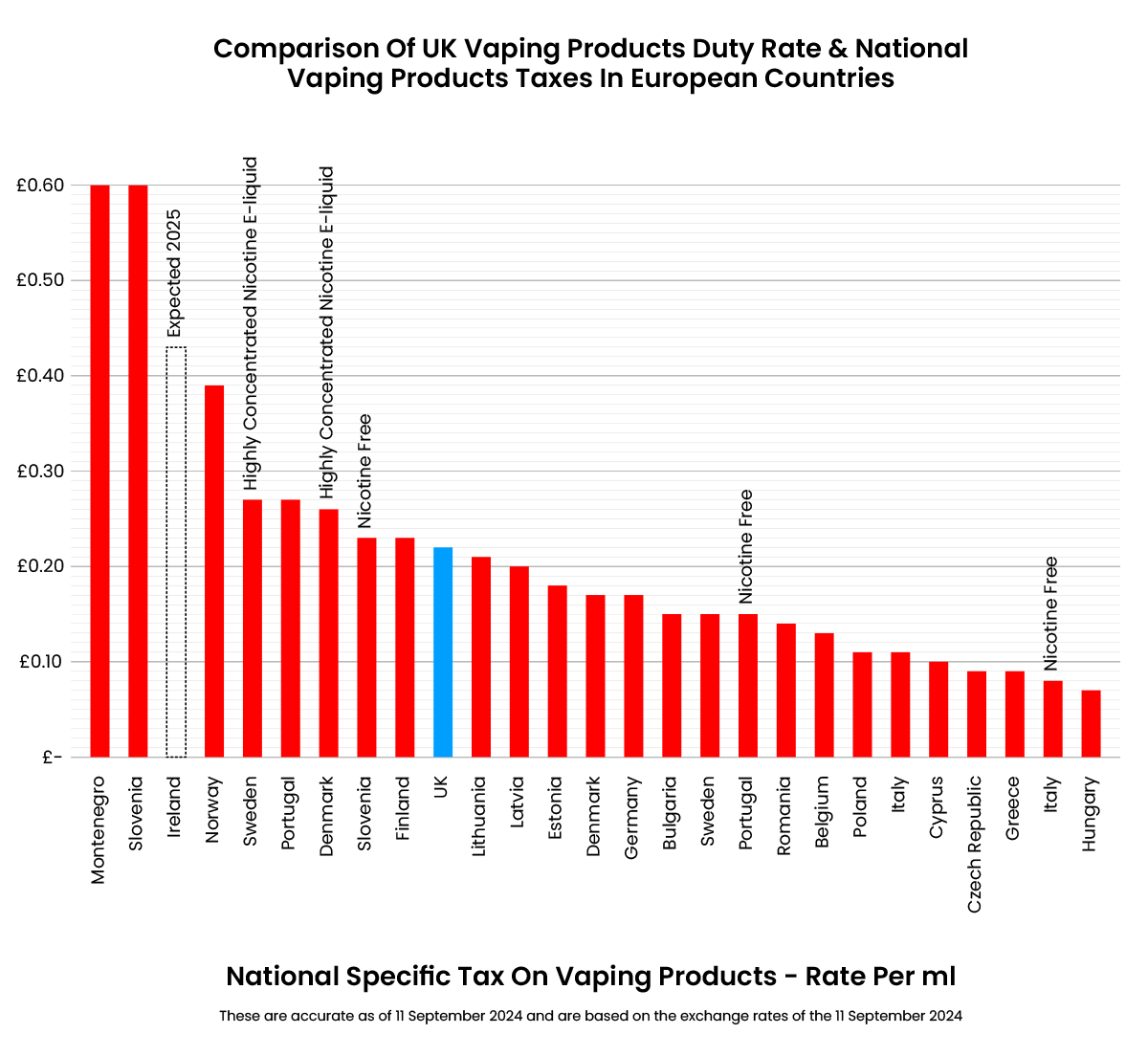What You Need To Know About The UK Vape Tax
The latest budget report, issued on the 30th October 2024, has highlighted a number of changes to the cost of everyday living, but, perhaps one of the most important, is a new duty tax on vapes.
Alongside the £2 cap on bus fares in England to rise to £3 from January, the 5p cut to fuel duty on petrol and diesel to be kept for another year and the tax on draught alcoholic drinks cut by 1.7%, your vape could now be double, triple or even four times the cost.
Table Of Contents
What Vapes Are Being Taxed?
The Labour government will be introducing a “flat rate duty on all vaping liquid” and a tax of £2.20 per 10ml of e-liquid will be introduced.
This tax, however, is also subject to VAT. This means it’s not a £2.20 rise, but in fact a £2.64 rise on a 10ml e-liquid – as an extra 20% VAT will be added onto it.
This means that if your standard 10ml e-liquid costs £3 today, it will rise to £5.64.
This is a blow to vapers across the UK and as this tax is “per 10ml”, products like shortfills will become incredibly expensive. For example, a standard 50ml shortfill will have an extra £13.20 of tax added onto its cost. Don’t forget to account for the cost of a nic shot either, there’ll be an extra £2.64 added to that too.



As we know, disposable vapes will be banned in June 2025, however, products like prefilled pods and certain big puff vapes will still be legal to buy in the UK – these will be subjected to the same measures. So, a 2ml pod will have an extra £0.53 added to them (£0.22 per ml + 20% VAT) and a 10ml big puff vape will cost an extra £2.64 (10ml tax + 20% VAT).
These measures will not affect nicotine pouches as they do not contain any e-liquid. However, the Tobacco & Vapes Bill could put pouches on par with vapes and also see them taxed in a similar way. This is just speculation at this point, but a lot can happen between now and 2026, and the government has plenty of time to put pouches under the same tax umbrella.
When Is The Vape Tax Being Introduced?
Rachel Reeves’ comments in Parliament have confirmed that this tax will come into effect on the 1st of October 2026. It’s the Government’s prediction that: “The duty will raise £525m in revenue, helping to fund vital public services such as the NHS, defence, education and smoking initiatives supporting to live a smoke-free life.” Through it’s introduction the UK will join 50 nations from across the world who already have a specific vape tax, including Norway, Canada, Sweden and Germany.

– Graph courtesy of HMRC Tobacco Index Report 2024
The above graph communicates the exact rate of tax that other countries across the world apply to their e-liquids per ml. As we can see, while the UK is by no means the lowest tax level – that award goes to Hungary – it’s less than half that of the most expensive country, Montenegro.
Why Is A Vape Tax Being Introduced?
The idea of a vape tax / duty isn’t new, in fact the previous Vape Consultation back in 2023 raised the question as to whether a levy should be introduced based on an e-liquid’s nicotine strength, with higher strength juices sitting in a higher tax band.
The government has cited various reasons as to why their tax is to be introduced, chief amongst which is “The duty will reduce the affordability of vapes which will in turn influence the accessibility of vapes to youth vapers.” It is hoped that the money generated by this tax will also be used to better fund enforcement and stop the scourge of illegal vapes.
Sceptics have argued that the government’s motives may have less to do with limiting underage vaping and more to do with making up the shortfall in tobacco tax. In 2021 the tobacco tax raised 10.19 billion pounds and this dropped to 9.38 billion pounds in 2023. This is a sizable gap that apparently vapers can help fill.
This does sound counterintuitive though, tobacco tax was largely introduced to support the NHS, and soak up some of the cost around treatment of smoking-related illnesses. As vaping doesn’t cause these illnesses, is the logic sound?
Similarly, the funds generated by tax are in no way “ring-fence” this means they can be appropriated by any department for any cause that’s deemed worthy – it goes in the same pot as the rest of the UK’s tax revenue. While it’s our hope that the money generated by this tax will also be used to better fund enforcement and stop the scourge of illegal vapes, there is no guarantee.
Is There A Better Alternative To The Vape Tax?
Enforcement of vaping laws is going to need to come from more than just a tax, there needs to be a more comprehensive model to ensure that vapes are being stocked and sold responsibly – if youth vaping is such a drastic issue.
We also disagree that making up for the shortfall on tobacco tax or protecting the vape industry should come down to vapers. Instead, we believe retailers and industry members should bear the responsibility – that’s why we helped create and fully endorse a Licensing Scheme which will both generate funds for the government and ensure responsible selling.
Is Vaping Still Cheaper Than Smoking?
It’s not all doom and gloom though, the Labour government has announced that the tobacco duty escalator will continue to operate to keep the cost of cigarettes high. They’ve also doubled-down in their bid to make smoking look less attractive through an extra, one-off tobacco duty too.
Both of these measures mean that while vaping will be more expensive – it’s still a cheaper, less harmful alternative to cigarettes. If you’re looking to find out exactly how much you could save by switching to a vape, you should check out our hand vaping vs. smoking cost calculator.
What Shall I Do Now?
October 2026 is a long way off yet, and when we have more updates on the tax we’ll provide them. Until then, it might be worth exploring your options a little more, there may be a more economical way to vape.
Sub ohm kits get through a lot of e-liquid, because they create a larger amount of vapour, and this is why people use shortfills with them. Unfortunately, swapping to smaller 10ml bottles won’t help save money as you’ll still get through the same amount of juice, and as the tax is applied per 10ml it’ll cost the same. Instead, it might be more efficient to use a kit that produces less vapour – like an MTL vape – and that can save money as they get through far less e-liquid per puff.
There are ways to save with MTL vapes too, swapping to a higher resistance coil means a lower power output, a smaller amount of vapour and a vape that gets through less e-liquid per puff. You could also look at a higher nicotine strength, this means you can vape less and still keep your cravings satisfied. Similarly if you’re using prefilled vapes, moving onto a refillable device offers the chance to pocket a bit more cash too.
Regardless of any experimentation, the good news is that vapes will always remain cheaper than cigarettes; our own prediction is that by the time the tax is introduced a pack of twenty could cost you £20 – at least!
If you have any questions about the tax or are looking for advice on your next vape, please don’t hesitate to contact our Customer Service team.




